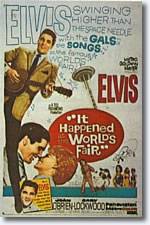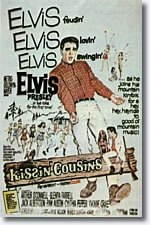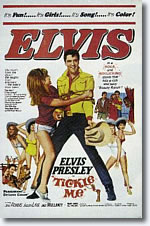Elvis - The Way It Should Have Been?
By Nick Ruck Keene (Source: Elvis Australia Nov 12, 2005)  |
| Devil in Disguise |
an alternative singles policy in the sixties Back in the sixties one of the many frustrations suffered by Elvis fans was the way RCA went about choosing his singles between March 1963 and the end of 1968. Right at the beginning of this period it was obvious to anyone with an ounce of intelligence and who was not hard of hearing that the quality of Presley's soundtrack recordings was slipping, and that the vastly superior songs from his new studio sessions, albeit that these were few and far between in number, were likely to fare much better in the charts. But the situation was made even worse by RCA because they invariably ignored the most commercial offerings that were available from the film scores. Each film managed to produce at least one decent track, as I elaborated upon in an earlier article 'Elvis at the Movies'. To cap it all, in an effort to break up the never ending stream of increasingly dire film singles, RCA persisted in dredging up leftovers from the previous decade or putting out previously released tracks taken from Elvis' early sixties studio albums. It was almost as if someone at RCA thought that Elvis was no longer capable of making hit records. Given that the huge success of 'Devil in Disguise' from the May 1963 sessions in Nashville should have dispelled any such notion, one would have thought it worthwhile issuing a follow up or two from the same batch of recordings. Some of the latter lay in the vaults until 1968.
In this article I will demonstrate that with a little more acumen Elvis Presley's chart positions could have been far better if greater thought had been given to his singles releases. Some music writers of the period will tell you that Elvis' chart blips of the mid sixties were inevitable because of the rise of the beat groups headed by the Stones and the Beatles. I certainly agree that in what was a more competitive era he most likely would have had to settle for fewer number one hits, but given the ease with which his main rival in Britain - Cliff Richard - sailed through it all I would suggest that Elvis could have done at least as well as Cliff, even with the indifferent quality of the material he was so often given to record by the film companies. If there had only been someone at the helm who had an ear for pop songs - which would have ruled out the Colonel - Presley would surely have been pretty solid Top Ten throughout the sixties.
So then here we go beginning in 1963 with an annual summarisation of the singles released in the UK, my brief opinion of the song together with its chart position and then my suggested alternatives along with my forecast of the chart positions such a release might have obtained - taking full account of the opposition :
 1963 releases:
1963 releases:
One broken heart for sale - too short / too tinny # 12
Devil in disguise - cleverly arranged/commercial # 1
Bossa Nova baby – dated sound / poor backing # 13
Kiss me quick - old LP track / fans already had it # 14
1963 Alternatives:
I'm falling in love tonight # 2 - Despite the rather overbearing roller rink organ supposedly meant to be firmly placed in the background, but unaccountably brought forward in the mix, this beautiful ballad from the film It Happened at the World's Fair was sung with such feeling by Elvis that it is scarcely possible to imagine it failing in the charts. The full richness of the King's voice comes through in such a way as to hold your attention until the very last note.
Devil in disguise – no change
I Think I'm Going To Like It Here # 3 - With Fun in Acapulco being such a major movie it would have been difficult to have resisted a single from this pleasant soundtrack, and given its success in the States where the beat groups had yet to break through; I would still have had Bossa Nova Baby as the B side - perhaps even as a double A side with my above choice - rather in the same way as happened when Wild in the Country / I feel so bad were coupled in 1961. The track I have chosen has considerable charm and a good tune going for it.
Western Union # 3 - Ah yes I hear you say was this track a not so subtle effort to copy the smash hit Return to Sender? Probably and that is why Elvis cut it for goodness sake – so why on earth was it not released? Shamelessly commercial it just might have managed a week at number one. Given that choices were so limited in the mid sixties a potential hit could not be ignored no matter what one or two critics might have said.
1964 releases:
Viva Las Vegas - great number but not commercial # 17
Kissin' Cousins - not an unreasonable choice # 10
Such a Night - why put out a track we all had? # 13
Ain't that loving you Baby? – Aussies loved it but so dated # 15
Blue Christmas - a classic but 7 years old # 11
1964 Alternatives:
It Hurts Me # 1 - One of finest vocal performances ever heard from Elvis finished up as a B side. Like many fans at the time I was incandescent with fury that this classic ballad was so poorly treated. The mixture of scorn and hurt which comes through in Presley's impassioned vocal has never been matched by anyone else, including Elvis and this track could have been a truly massive hit topping the charts for 6 weeks or more.
 C'mon Everybody # 3 - Despite the poor balance between singer and backing and the hollow sounding mix this very catchy, if rather artificial rocker was just right for the charts of the day-and great for dancing at parties. The film Viva Las Vegas produced Presley's best mid sixties soundtrack yet it ended up being confined to an EP. As Alice would say it just got curioser and curioser.
C'mon Everybody # 3 - Despite the poor balance between singer and backing and the hollow sounding mix this very catchy, if rather artificial rocker was just right for the charts of the day-and great for dancing at parties. The film Viva Las Vegas produced Presley's best mid sixties soundtrack yet it ended up being confined to an EP. As Alice would say it just got curioser and curioser.
Tender Feeling # 2 - Even if Elvis sounds a touch subdued-as well he might given the other songs he had to sing in Kissin' Cousins - this track had hit written all over it. Set to the traditional Southern Civil war ballad 'Shenandoah' and with a lovely backing the melody is so strong it just couldn't miss.
Memphis Tennessee (1964 version) # 1 - Yes I know that singer Johnny Rivers infamously rushed out a cover version of this Chuck Berry song which Elvis had specifically re-recorded as his next single in a short session that January. Elvis innocently played it to Rivers when the latter visited Graceland shortly afterwards. However as the Rivers version never saw the light of day in the charts outside the US I fail to see why the Presley recording could not have been released at least in the UK and in places like Australia. It would surely have topped the charts. Wonderfully infused throughout with that typically happy Berry road music feeling and blessed with some exceptionally clever lyrics it was just right for the times, although strangely it was never a big hit for the author.
1965 releases:
Do the Clam – despite Aussie success this was plain embarrassing # 19
Crying in the Chapel - classic/should have been released earlier # 1
Tell Me Why - wonderfully bluesy but recorded in 1957!! # 15
1965 Alternatives:
You'll be Gone # 1 - Quite why this dramatic ballad was left off the 1962 album 'Pot Luck' is something only the good Lord knows, but its subsequent relegation to the B side of the dreaded 'Do the Clam' was another shocking waste of a potential hit single. It had all the right ingredients and the added novelty of being written by Elvis could only have helped to re-establish his artistic credibility at a time, when because of the musicals, it needed a bit of a boost.
Crying in the Chapel – no change
 I'm Yours # 3 - The songs from Tickle Me were made up of old studio album tracks - but probably thanks to the impact of 'Crying in the Chapel' the two single releases from the film did pretty well in the States and down under, yet for some reason neither were released in the UK. Thus in the UK there was no follow up to the biggest Presley hit of the mid sixties. Very odd. 'I'm Yours' was very very commercial -far more so than any of the other old LP tracks put out at the time. Just this once I would have broken my rule not to release an oldie.
I'm Yours # 3 - The songs from Tickle Me were made up of old studio album tracks - but probably thanks to the impact of 'Crying in the Chapel' the two single releases from the film did pretty well in the States and down under, yet for some reason neither were released in the UK. Thus in the UK there was no follow up to the biggest Presley hit of the mid sixties. Very odd. 'I'm Yours' was very very commercial -far more so than any of the other old LP tracks put out at the time. Just this once I would have broken my rule not to release an oldie.
Finders Keepers Losers Weepers # 4 - A happy go lucky rocker- which like 'Devil in Disguise' relied rather too heavily on Elvis' charm - yet had sufficient appeal to have been a substantial hit in 1965, although probably not any later given the swing towards more 'heavy' rock songs which came about in the late sixties.
1966 releases:
Blue River – clearly one of the weaker songs from 63 sessions # 22
Frankie and Johnny - not easy to oppose but see below # 21
Love Letters - superb and an obvious choice - in 1967 # 6
All that I Am - having stiffed in the States why release it? # 18
If every day was like Christmas - sheer class / underrated # 9
1966 Alternatives:
Please Don't Stop Loving Me #2 - It had long been clear to a blind man that fans often preferred Elvis' ballads to his show tunes and good as Frankie and Johnny was of its genre it simply did not cut the mustard in terms of chart appeal whereas my choice-the flipside – was a quality ballad sung with soul and feeling that suggested hit all over to me and in spades as they say.
Down in the Alley # 3 - Loud enough and rude enough this R&B chanter would have hogged radio play and made people sit up and take notice of Elvis. It would have gained him valuable brownie points with hip DJ's of the day.
This is my Heaven / Sand Castles (double A side) # 1 - From the otherwise forgettable film Paradise Hawaiian Style this Hawaiian pastiche number hit all the right buttons and I really do not know how RCA failed to put it out as a single because it was so obviously commercial. Okay so the song is not as good as 'Can't help falling in Love' but then what was? The cleverly written and scored 'Sand Castles' should perhaps share the limelight.
If Every Day Was Like Christmas – no change
1967 releases:
Indescribably Blue – terrific/ see comments below # 22
Long Legged Girl - fake effort to sound trendy # 37
You gotta stop - Elvis sounds off mike/woeful song # 49
There's always me - first released in 1961!! - Flop
Big Boss Man - great but not suitable as a single - Flop
1967 Alternatives:
Indescribably Blue - no change NB - I am convinced that had Elvis retained his automatic Top 5 chart status until 1967 then this single would have done much better in the charts than it did. In all honesty I cannot fault its release and I would not have acted differently. A very well produced record.
Tomorrow is a Long Time # 2 - Elvis singing a Dylan song in 1967 would have electrified everyone. Real cool man! Yes it is long for single - but what a performance from Elvis. Of course it would have been a hit.
Hi Heel Sneakers # 8 - By now I would have expected Elvis' singles to be dipping slightly in the charts no matter what singles policy was followed. He just wasn't making enough non film songs and with his films falling away at the box office his popularity hit an all time career low. Even so this track - a hit stateside in 1964 for Tommy Tucker - would have still made the Top Ten.
Love Letters - no change
1968 releases:
Guitar Man - fabulous country rocker no 19 US Male-controversial lyrics but irresistible # 15
You'll Never Walk Alone - virtuoso performance but a hit? # 44
Your Time Hasn't Come Yet Baby – charming but weak # 22
A Little Less Conversation - feeble backing Flop
Guitar Man - no change
US Male - no change
NB - Both these releases rate amongst the best Elvis rockers of the sixties and would have been much bigger hits if Elvis was still popular and critically getting the airplay.
1968 Alternatives:
Too Much Monkey Business # 9 - There was nothing else available that would have been suitable. By now I would have been reduced to scraping the bottom of the barrel, but I think that this song would at least have kept Elvis in the top ten. That said I would-shades of 1959- have halted all single releases between 'US Male' and 'If I Can Dream' in order to draw clear blue water between the Hollywood era and the Comeback TV special.
Edge of Reality # 8 - The film songs were improving rapidly at this time and if forced to come up with a single release against my preferences then this unusual track would have been my choice.
So there it is. Fans will have there own thoughts, but can anyone dispute my contention that the above singles release policy would have fared markedly better than the shambolic approach adopted by RCA? Elvis suffered from a management that became ever more complacent after he left the army, but when Felton Jarvis joined the team in 1966 one might have expected he would have been able to exert greater order and control than he did. Indeed Felton was as guilty of failing to stand up to Elvis as Elvis was in failing to stand up to the Colonel. Another time I will look at the seventies singles releases, and in particular how the mistakes of 1971 in the USA might have been avoided…but that is another story.
Nick Keene
Edited by Qwest - 19 years ago






 Paul Simon is one of those artists who is known as being a part of a specific genre, in his case folk music, but who has contibuted significantly to World Beat.
Paul Simon is one of those artists who is known as being a part of a specific genre, in his case folk music, but who has contibuted significantly to World Beat.


















